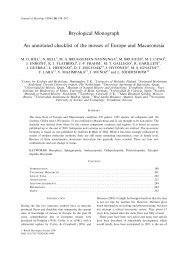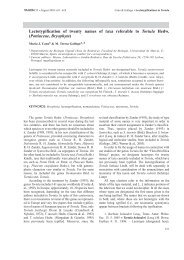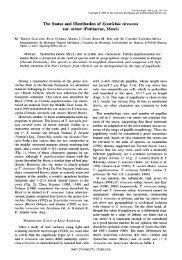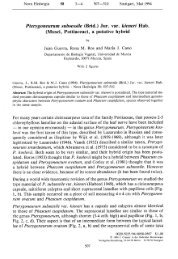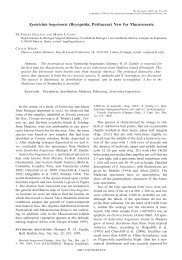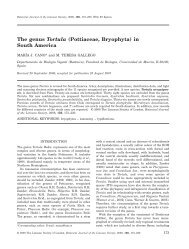Typification of the names of some infraspecific taxa in ... - Pottiaceae
Typification of the names of some infraspecific taxa in ... - Pottiaceae
Typification of the names of some infraspecific taxa in ... - Pottiaceae
You also want an ePaper? Increase the reach of your titles
YUMPU automatically turns print PDFs into web optimized ePapers that Google loves.
TAXON 56 (3) • August 2007: 949–952Cano • <strong>Typification</strong> and taxonomy <strong>in</strong> <strong>the</strong> Tortula subulata complex<strong>Typification</strong> <strong>of</strong> <strong>the</strong> <strong>names</strong> <strong>of</strong> <strong>some</strong> <strong><strong>in</strong>fraspecific</strong> <strong>taxa</strong> <strong>in</strong> <strong>the</strong> Tortula subulatacomplex (<strong>Pottiaceae</strong>, Bryophyta) and <strong>the</strong>ir taxonomic dispositionMaría J. CanoDepartamento de Biología Vegetal (Área de Botánica), Facultad de Biología, Universidad de Murcia,30100 Murcia, Spa<strong>in</strong>. mcano@um.esTypes for <strong>the</strong> <strong>names</strong> Barbula saxicola Lamy, Barbula subulata var. longifolia K<strong>in</strong>db., Syntrichia alp<strong>in</strong>a Brid.,Tortula <strong>in</strong>ermis var. submarg<strong>in</strong>ata Schiffn., and Tortula subulata var. compacta Schiffn., are designatedhere. Syntrichia alp<strong>in</strong>a is considered conspecific with T. subulata Hedw., with which Tortula <strong>in</strong>ermis var.submarg<strong>in</strong>ata and T. subulata var. compacta are also synonymized, as is Barbula subulata var. longifoliawith T. schimperi M.J. Cano & al. Barbula saxicola is here considered to apply to <strong>the</strong> species currently knownas Dialytrichia fragilifolia (Bizot & Cl. Roux) F. Lara; as B. saxicola has priority, this necessitates <strong>the</strong> newcomb<strong>in</strong>ation D. saxicola (Lamy) M.J. Cano.KEYWORDS: Bryophyta, lectotypification, nomenclature, <strong>Pottiaceae</strong>, taxonomy, TortulaINTRODUCTIONMany authors have commented on <strong>the</strong> taxonomicproximity <strong>of</strong> Tortula <strong>in</strong>ermis (Brid.) Mont., T. mucronifoliaSchwägr., and T. subulata Hedw. (Schimper, 1876;Mönkemeyer, 1927; Podpěra, 1954), whose morphologicaldelimitation and taxonomic status have been treated<strong>in</strong> different ways. A large number <strong>of</strong> <strong><strong>in</strong>fraspecific</strong> <strong>taxa</strong>have been described reflect<strong>in</strong>g <strong>the</strong> high morphologicalvariation and <strong>in</strong>tergradation <strong>in</strong> <strong>the</strong>se species (see Warnstorf,1912). This complex <strong>of</strong> <strong>taxa</strong>, <strong>the</strong> Tortula subulatacomplex, is ma<strong>in</strong>ly dist<strong>in</strong>guished from <strong>the</strong> rest <strong>of</strong> Tortulaby <strong>the</strong> long leaves, (2.2–)2.5–5.5 mm long, with no hairpo<strong>in</strong>t(generally mucronate or apiculate) and a long capsulewith twisted peristome teeth emerg<strong>in</strong>g from a high,tessellated basal membrane similar to those present <strong>in</strong> <strong>the</strong>genus Syntrichia Brid.While prepar<strong>in</strong>g a morphometric and molecular study<strong>of</strong> <strong>the</strong> Tortula subulata complex (Cano & al., 2005), typematerial <strong>of</strong> <strong>some</strong> <strong>names</strong> <strong>of</strong> <strong><strong>in</strong>fraspecific</strong> <strong>taxa</strong> currently<strong>in</strong>cluded <strong>in</strong> this group was studied. Some <strong>of</strong> <strong>the</strong>se weretypified <strong>in</strong> a previous study (Cano & Gallego, 2003),although most rema<strong>in</strong>ed untypified and <strong>the</strong>ir taxonomicdisposition was <strong>in</strong> <strong>some</strong> cases erroneous. In addition,one name previously <strong>in</strong>cluded <strong>in</strong> this complex <strong>of</strong> <strong>taxa</strong>on account <strong>of</strong> its long and mucronate leaves was typifiedand found not be referable to this group any more. Basedon a morphological study and with <strong>the</strong> aim <strong>of</strong> enhanc<strong>in</strong>gnomenclatural stability, lectotypes for five <strong>names</strong> <strong>of</strong> <strong>taxa</strong>currently <strong>in</strong>cluded <strong>in</strong> <strong>the</strong> T. subulata complex are proposed.All type citations refer to <strong>the</strong> <strong>in</strong>formation on <strong>the</strong>labels <strong>of</strong> <strong>the</strong> type material. In all cases where <strong>the</strong> types aredesignated, <strong>the</strong> first name given is <strong>the</strong> one be<strong>in</strong>g typified.The accepted <strong>names</strong> are shown <strong>in</strong> bold.TYPIFICATION AND TAXONOMY1. Barbula saxicola Lamy <strong>in</strong> Rev. Bryol. 2: 67. 1875 ≡Tortula subulata f. saxicola (Lamy) Podp., Consp.Musc. Eur.: 250. 1954 ≡ Dialytrichia saxicola (Lamy)M.J. Cano, comb. nov. – Type citation: Sur la surfacenue d’un rocher à l’us<strong>in</strong>e de Parpaillat près d’Isle lelong de la route d’Aixe; sur les parois extérieures desmurs de l’église de Sa<strong>in</strong>t-Priest-sous-Aixe. – Lectotype(designated here): [France]: “Haute-Vienne, surles murs de Sa<strong>in</strong>t-Priest-sous-Aixe”, 26 Mai 1872, E.Lamy s.n. – S! (No. B63566)= Dialytrichia mucronata var. fragilifolia Bizot & Cl.Roux <strong>in</strong> Rev. Bryol. Lichénol. 36: 110. 1969 ≡ D. fragilifolia(Bizot & Cl. Roux) F. Lara, Fl. Bri<strong>of</strong>. Ibér.<strong>Pottiaceae</strong>: Timiella, […]: 26. 2005.Lamy de la Chapelle (1875) mentioned <strong>in</strong> <strong>the</strong> protologuethat W.P. Schimper and B. Boulay thought thathis plant could be Barbula subulata (Hedw.) P. Beauv.,although <strong>the</strong>y saw <strong>some</strong> differences between both <strong>taxa</strong>, <strong>the</strong>new taxon hav<strong>in</strong>g: “des feuilles obtuses, mo<strong>in</strong>s longues,mo<strong>in</strong>s larges, d’un vert plus foncé, à tissu plus dense mo<strong>in</strong>stransparent, non marg<strong>in</strong>ées, à bords replies en-dessous.”Accord<strong>in</strong>g to Stafleu & Cowan (1979), <strong>the</strong> orig<strong>in</strong>almaterial <strong>of</strong> Lamy de la Chapelle is kept at PC; however,no syntypes were found <strong>in</strong> this herbarium (E. Bury, pers.comm.). Additionally, no material <strong>of</strong> this species was <strong>in</strong>BR, where duplicates <strong>of</strong> Lamy de la Chapelle are deposited.Surpris<strong>in</strong>gly, a syntype <strong>of</strong> this name was found at S.This syntype is <strong>in</strong> total accordance with <strong>the</strong> descriptionprovided and is chosen as lectotype. After a study <strong>of</strong> thisspecimen, it is concluded that it does not belong to <strong>the</strong> genusTortula, an assignment that Podpěra (1954) suggested949
Cano • <strong>Typification</strong> and taxonomy <strong>in</strong> <strong>the</strong> Tortula subulata complexTAXON 56 (3) • August 2007: 949–952and that was followed <strong>in</strong> Wijk & al. (1959, 1969). The typespecimen shows quadrate, th<strong>in</strong>-walled marg<strong>in</strong>al cells <strong>of</strong><strong>the</strong> leaf disposed <strong>in</strong> 2-strata, and a nerve with two stereidbands, <strong>the</strong> dorsal band be<strong>in</strong>g crescent-shaped, which placesit <strong>in</strong> <strong>the</strong> genus Dialytrichia (Schimp.) Limpr. Accord<strong>in</strong>g toLara (2005, 2006), two species can be recognized <strong>in</strong> <strong>the</strong>genus Dialytrichia : D. mucronata (Brid.) Broth. <strong>in</strong> Engler& Prantl, Nat. Pflanzenfam. 1(3): 412. 1902 (Barbulamucronata Brid., Muscol. Recent. Suppl. 1: 268. 1806)characterized by leaves not fragile and entire marg<strong>in</strong>s; andD. fragilifolia with fragile leaves and crenate marg<strong>in</strong>s. Thetype <strong>of</strong> Barbula saxicola shows fragile leaves and crenatemarg<strong>in</strong>s and is here considered to belong to <strong>the</strong> species thatLara (2005) named D. fragilifolia. However, <strong>the</strong> transfer<strong>of</strong> Barbula saxicola to <strong>the</strong> genus Dialytrichia necessitates<strong>the</strong> new comb<strong>in</strong>ation D. saxicola (Lamy) M.J. Cano, s<strong>in</strong>cesaxicola is <strong>the</strong> oldest available epi<strong>the</strong>t applicable to <strong>the</strong>species recently named D. fragilifolia.2. Barbula subulata var. longifolia K<strong>in</strong>db. <strong>in</strong> Bull.Torrey Bot. Club 17: 89. 1890 ≡ Tortula subulatavar. longifolia (K<strong>in</strong>db.) Paris, Index Bryol., ed. 2, 5:60. 1906 – Type citation: on <strong>the</strong> base <strong>of</strong> trees nearVictoria, Vancouver Island and on rocks at Yale, B.C.– Lectotype (designated here): [Canada] “British Columbia,Yale”, 1875, J. Macoun s.n. – S! (No. B63565)[= Tortula schimperi M.J. Cano & al. <strong>in</strong> Bot. J. L<strong>in</strong>n.Soc. 149: 346. 2005].K<strong>in</strong>dberg (<strong>in</strong> Macoun, 1890) described this taxonas an <strong>in</strong>termediate between T. angustata L<strong>in</strong>db. andT. subulata, characterized by leaves, which are long andnarrow, acum<strong>in</strong>ate and acute, dist<strong>in</strong>ctly denticulate above,papillose, yellow, bordered, with a long excurrent costa,but shorter <strong>in</strong> <strong>the</strong> perichaetial leaves. Three syntypescited <strong>in</strong> <strong>the</strong> protologue were found at S from <strong>the</strong> K<strong>in</strong>dbergherbarium; <strong>the</strong>se were all collected by Macoun andlabelled as var. longifolia : one labelled “Vancouver Island,Victoria” (B63564), one from “Yale” (B63565), and <strong>the</strong>third merely labelled “British Columbia” (B63563). Thepacket labelled as be<strong>in</strong>g from Victoria, Vancouver Island(B63564) conta<strong>in</strong>ed two envelopes <strong>in</strong>side. That marked“b” is a specimen with smooth upper cells which correspondto those <strong>of</strong> T. mucronifolia, whereas <strong>the</strong> specimenmarked “c” reflects <strong>the</strong> description provided <strong>in</strong> <strong>the</strong> protologue.The o<strong>the</strong>r two syntypes from S also agree with<strong>the</strong> diagnosis. The material from Yale and marked with<strong>the</strong> number B63565 is chosen as lectotype <strong>of</strong> this name,because it is not mixed, unlike <strong>the</strong> syntype from Victoria,and it is better preserved than <strong>the</strong> syntype labelled “BritishColumbia” (B63563).The lectotype specimen shows a border <strong>of</strong> elongateand bistratose marg<strong>in</strong>al cells, which are characteristic <strong>of</strong>T. schimperi and Barbula subulata var. longifolia is heresynonymized under that species.3. Syntrichia alp<strong>in</strong>a Brid., Muscol. Recent. Suppl. 4:97. 1819 (“1818”) ≡ Tortula alp<strong>in</strong>a (Brid.) Arn., Disp.Méth. Mousses: 38. 1925 ≡ Tortula subulata subf. angustifoliaWarnst. <strong>in</strong> Hedwigia 52: 71. 1912 ≡ Tortulamucronifolia f. angustifolia Warnst. <strong>in</strong> Hedwigia 52:79. 1912 – Type citation: In Pyrenaeis ubi Junio 1803legimus et <strong>in</strong> Alpibus Helveticis ubi Thomas serius<strong>in</strong>venit. – Lectotype (designated here): [Switzerland]“Alpibus … Helvetia”, 1803, Thomas s.n. – B-Bridel![= Tortula subulata Hedw., Sp. Musc. Frond.: 122.1801].Bridel (1819) described Syntrichia alp<strong>in</strong>a based upontwo specimens collected <strong>in</strong> <strong>the</strong> Pyrenees and Switzerlandand provided <strong>the</strong> follow<strong>in</strong>g diagnosis: “caule erecto ramos<strong>of</strong>astigiato, foliis oblongo-lanceolatis, acutis strictis,supremis siccitate apice <strong>in</strong>curvis, capsulae cyl<strong>in</strong>dricae erecto cernuae operculo conico subulato”. The two syntypesmentioned <strong>in</strong> <strong>the</strong> protologue are deposited <strong>in</strong> <strong>the</strong>Bridel herbarium <strong>in</strong> B. The sample from <strong>the</strong> Pyreneeshas only one plant, which lacks a capsule and does nothave an <strong>in</strong>curved apex. The specimen from Switzerlandhas all <strong>the</strong> characteristics referred to <strong>the</strong> protologue and isbetter preserved. For this reason, this latter specimen fromSwitzerland is chosen as lectotype <strong>of</strong> this name.After study<strong>in</strong>g <strong>the</strong> type material, it is concluded thatSyntrichia alp<strong>in</strong>a should be <strong>in</strong>cluded <strong>in</strong> <strong>the</strong> variation <strong>of</strong>T. subulata, s<strong>in</strong>ce it has upper and middle lam<strong>in</strong>al cellswith conspicuous papillae (<strong>in</strong> T. mucronifolia <strong>the</strong>y aresmooth or, more rarely, have <strong>in</strong>conspicuous papillae) andelongate middle marg<strong>in</strong>al cells (<strong>in</strong> T. mucronifolia <strong>the</strong>yare usually quadrate or short-rectangular).Warnstorf (1912) placed Syntrichia alp<strong>in</strong>a <strong>in</strong> synonymyunder Tortula mucronifolia f. angustifolia Warnst.Warnstorf provided two different taxonomic treatments<strong>in</strong> this paper: an “Übersicht über den Formenkreis derTortula subulata” (pp. 69–71) and a ”Zweite übersichtlicheDarstellung …” (pp. 73–80). In <strong>the</strong> first overview,<strong>in</strong> which <strong>the</strong> variation is accommodated entirely underT. subulata, he published a Tortula subulata subf. angustifoliaWarnst., provid<strong>in</strong>g a description (<strong>in</strong> <strong>the</strong> key) butcit<strong>in</strong>g no specimens, whereas <strong>in</strong> <strong>the</strong> second treatmentwhich exactly follows <strong>the</strong> first taxonomic structure onlywith change <strong>of</strong> rank, <strong>the</strong> variation is accommodatedunder several species, <strong>in</strong>clud<strong>in</strong>g T. mucronifolia, underwhich “f. angustifolia Warnst.” appears. Although hegave no description <strong>of</strong> this name, <strong>the</strong> identical structuremakes it clear that it is an alternative name for whatearlier <strong>in</strong> <strong>the</strong> same paper (p. 71) he had called Tortulasubulata subf. angustifolia and, be<strong>in</strong>g prior to 1953,both <strong>names</strong> are validly published (Art. 34.2 <strong>of</strong> <strong>the</strong> ICBN[McNeill & al., 2006]). The two <strong>names</strong>, although necessarilyhomotypic <strong>the</strong>mselves, are not necessarily homotypicwith Syntrichia alp<strong>in</strong>a because Warnstorf (1912)provided a description <strong>of</strong> T. subulata subf. angustifolia950
TAXON 56 (3) • August 2007: 949–952Cano • <strong>Typification</strong> and taxonomy <strong>in</strong> <strong>the</strong> Tortula subulata complexand under T. mucronifolia f. angustifolia cited a Braunspecimen from Switzerland as well as <strong>in</strong>dicat<strong>in</strong>g tha<strong>the</strong> has seen material (presumably <strong>the</strong> type) <strong>of</strong> S. alp<strong>in</strong>a.The Braun syntype <strong>of</strong> T. mucronifolia f. angustifoliawas not found at B. Therefore, <strong>in</strong> order to simplify andclarify this unusual nomenclatural situation <strong>the</strong> name T.subulata subf. angustifolia (and hence T. mucronifolia f.angustifolia) is here lectotypified with <strong>the</strong> lectotype <strong>of</strong> S.alp<strong>in</strong>a (see above). Consequently, <strong>the</strong>se <strong>names</strong> becomehomotypic with Syntrichia alp<strong>in</strong>a which is conspecificwith T. subulata.4. Tortula <strong>in</strong>ermis var. submarg<strong>in</strong>ata Schiffn. <strong>in</strong> Verh.Zool.-Bot. Ges. Wien 69: 336. 1920 – Type citation:[Greece] Phokis: Delphi, an Böschungen, c. 600 m(no. 13) ebendaselbst, am Schatzhause der A<strong>the</strong>ner,<strong>in</strong> wenigen Stengeln unter anderen Moosen (no. 18);Parnaß, Hochfläche “Livadhi” über 1200 m, Kalk(no. 84). – Lectotype (designated here): “Phokis, Parnass,Hochfläche ‘Livadi’, 1200 m, V. Schiffner s.n.(Universitätreise nach Griechenland 8–26 Apr 1911no. 84” – FH!; isolectotype: W! [= Tortula subulataHedw., Sp. Musc. Frond.: 122. 1801.]Schiffner (<strong>in</strong> Schiffner & Baumgartner, 1920) ma<strong>in</strong>lydist<strong>in</strong>guished this taxon from <strong>the</strong> typical phenotypes <strong>of</strong> T.<strong>in</strong>ermis by leaves with a marg<strong>in</strong> <strong>of</strong> differentiated thickerwalled cells. In <strong>the</strong> Schiffner herbarium at FH, <strong>the</strong> threesyntypes <strong>of</strong> this name mentioned <strong>in</strong> <strong>the</strong> protologue weredetected. In W, two syntypes (no. 13 and no. 84) werefound. Numbers 13 and 18 show leaf marg<strong>in</strong>s that are regularlyrecurved from <strong>the</strong> apex to near <strong>the</strong> base with oblateupper and middle cell marg<strong>in</strong>s. No clearly differentiatedborder is dist<strong>in</strong>guished. In fact, <strong>the</strong>se specimens show<strong>the</strong> typical characteristics <strong>of</strong> T. <strong>in</strong>ermis var. <strong>in</strong>ermis and<strong>the</strong>y are identified with that taxon. However, <strong>the</strong> syntypefrom Parnass (no. 84) shows irregularly recurved leafmarg<strong>in</strong>s (it is possible to f<strong>in</strong>d, <strong>in</strong> <strong>the</strong> same plant, leaveswith recurved marg<strong>in</strong>s <strong>in</strong> <strong>the</strong> middle part, from basalthird to <strong>the</strong> apex or upper third or totally plane, and even<strong>in</strong> <strong>the</strong> same leaf one marg<strong>in</strong> may be plane and ano<strong>the</strong>rrecurved) formed by more quadrate or rectangular cells,although <strong>some</strong> oblate cells can be seen. It also showsthicker walled marg<strong>in</strong>al cells. This, toge<strong>the</strong>r with <strong>the</strong> lessrecurved or plane marg<strong>in</strong>s, provides a more differentiatedborder than <strong>in</strong> T. <strong>in</strong>ermis. Therefore, syntype no. 84 ismore <strong>in</strong> accordance with <strong>the</strong> description provided <strong>in</strong> <strong>the</strong>protologue and is chosen as lectotype <strong>of</strong> Tortula <strong>in</strong>ermisvar. submarg<strong>in</strong>ata.Accord<strong>in</strong>g to Düll (1992) this variety has been recordedfrom Corsica, Crete, Cyprus, and Greece. It hasalso been detected <strong>in</strong> <strong>the</strong> Canary Islands, Morocco, Sicily,Spa<strong>in</strong>, Syria, Turkey (Cano, 2006), and Armenia (Townsend,2005). Accord<strong>in</strong>g to Cano & al. (2005), this taxonshould be <strong>in</strong>cluded <strong>in</strong> Tortula subulata.5. Tortula subulata var. compacta Schiffn. <strong>in</strong> Österr. Bot.Z. 48: 390. 1898 – Type citation: [Czech Republic] Inder Gegend von Prag ist auf Kalk- und Kieselschieferfelsen(z. B. bei Selc; ober Zámky etc.). – Lectotype(designated here): “Prag: Kieselschieferfelsen an derStrasse h<strong>in</strong>ter Selc”, 22 Jul 1898, V. Schiffner s.n.– FH! [= Tortula subulata Hedw., Sp. Musc. Frond.:122. 1801].In PC <strong>the</strong>re is one syntype labelled “Bei Prag” from<strong>the</strong> Schiffner herbarium. In <strong>the</strong> Schiffner herbarium <strong>in</strong>FH, three syntypes labelled as Prague (two from Selcand ano<strong>the</strong>r from Zámky) were found. The syntype atFH collected “an der Strasse h<strong>in</strong>ter Selc” is selected aslectotype, because it is <strong>the</strong> syntype better preserved andis <strong>in</strong> accordance with <strong>the</strong> protologue.Accord<strong>in</strong>g to Schiffner (1898), this taxon is characterizedby its compact turfs, its short and narrow capsule,and leaves which <strong>some</strong>times have marg<strong>in</strong>s recurved tonear <strong>the</strong> apex. All <strong>the</strong>se characters are <strong>in</strong>cluded <strong>in</strong> <strong>the</strong>variation shown by T. subulata.ACKNOWLEDGEMENTSWe thank <strong>the</strong> curators <strong>of</strong> B, FH, GJO, NY, PC, S, and Wfor <strong>the</strong>ir valuable help with <strong>the</strong> location and loans <strong>of</strong> <strong>the</strong> typematerial; J. Muñoz for provid<strong>in</strong>g bibliography; J. Guerra for hisreview <strong>of</strong> a first version <strong>of</strong> <strong>the</strong> manuscript and an anonymousreferee for improv<strong>in</strong>g <strong>the</strong> manuscript. F<strong>in</strong>ancial support wasprovided by <strong>the</strong> Spanish “M<strong>in</strong>isterio de Educación y Ciencia”(Projects CGL2004-00788/BOS and CGL2006-00599).LITERATURE CITEDBridel, S.E. 1819. Muscologia Recentiorum Supplementum 4.A. Ukertum, Gothae.Cano, M.J. 2006. Tortula. Pp. 146–176 <strong>in</strong>: Guerra, J., Cano,M.J. & Ros, R.M. (eds.), Flora Bri<strong>of</strong>ítica Ibérica, vol.3. (Pottiales: <strong>Pottiaceae</strong>, Encalyptales: Encalyptaceae).Universidad de Murcia, Sociedad Española de Briología,Murcia.Cano, M.J. & Gallego, M.T. 2003. Lectotypification <strong>of</strong> twenty<strong>names</strong> <strong>of</strong> <strong>taxa</strong> referable to Tortula Hedw. (<strong>Pottiaceae</strong>, Bryo -phyta). Taxon 52: 611–618.Cano, M.J., Werner, O. & Guerra, J. 2005. A morphometricand molecular study <strong>in</strong> Tortula subulata complex (<strong>Pottiaceae</strong>,Bryophyta). Bot. J. L<strong>in</strong>n. Soc. 149: 333–350.Düll, R. 1992. Distribution <strong>of</strong> <strong>the</strong> European and Macaronesianmosses (Bryophyt<strong>in</strong>a). Annotations and Progress. Bryol.Beitr. 8/9: 1–223.Lamy de la Chapelle, E. 1875. Mousses et hépatiques de laHaute-Vienne. Rev. Bryol. 2: 49–101.Lara, F. 2005. Dialytrichia. Pp. 22–27 <strong>in</strong>: Guerra, J. & Cros,R.M. (eds.), Flora Bri<strong>of</strong>ítica Ibérica. <strong>Pottiaceae</strong>: Timmiella,Bryoerythrophyllum, C<strong>in</strong>clidotus, Dialytrichia.Sociedad Española de Briología, Murcia.951
Cano • <strong>Typification</strong> and taxonomy <strong>in</strong> <strong>the</strong> Tortula subulata complexTAXON 56 (3) • August 2007: 949–952Lara, F. 2006. <strong>Pottiaceae</strong>: Dialytrichia. Pp. 264–269 <strong>in</strong>:Guerra, J., Cano, M.J. & Ros, R.M. (eds.), Flora Bri<strong>of</strong>íticaIbérica, vol. 3 (Pottiales: <strong>Pottiaceae</strong>, Encalyptales: Encalyptaceae).Universidad de Murcia, Sociedad Española deBriología, Murcia.Macoun, J. 1890. Contributions to Canadian Bryology. – No.2. Bull. Torrey Bot. Club. 17: 83–90.McNeill, J., Barrie, F.R., Burdet, H.M., Demoul<strong>in</strong>, V., Hawksworth,D.L., Marhold, K., Nicolson, D.H., Prado, J.,Silva, P.C., Skog, J.E., Wiersema, J.H. & Turland, N.J.(eds.) 2006. International Code <strong>of</strong> Botanical Nomenclature(Vienna Code) adopted by <strong>the</strong> Seventeenth InternationalBotanical Congress Vienna, Austria, July 2005. A.R.G.Gantner Verlag, Ruggell. [Regnum Veg. 146]Mönkemeyer, W. 1927. Die Laubmoose Europas. Andreales–Bryales.In: L. Rabenhorst’s Kryptogamenflora vonDeutschland, Österreich und der Schweiz, vol. 4. AkademischeVerlagsgesellschaft, Leipzig.Podpěra, J. 1954. Conspectus Muscorum Europaeorum. ČeskoslovenskéAkademie Ved, Praha.Schiffner, V. 1898. Interessante und neue Moose der böhmischenFlora. Österr. Bot. Z. 48: 386–394.Schiffner, V. & Baumgartner, J. 1920. Beiträge zur Kenntnisder Flora Griechenlands. B. Leber- und Laubmoose. Verh.Zool.-Bot. Ges. Wien 69: 313–341.Schimper, W.P. 1876. Synopsis Muscorum Europaeorum PraemissaIntroductione de Elementis Bryologicis Tractante,vol. 2. E. Schweizerbart, Stuttgart.Stafleu, F.A. & Cowan, R.S. 1979. Taxonomic Literature, 2nded., vol. II. H–Le. Bohn, Scheltema & Holkema, Utrecht.[Regnum Veg. 98]Townsend, C.C. 2005. Mosses from <strong>the</strong> Caucasian region andeastern Turkey. J. Bryol. 27: 143–152.Warnstorf C. 1912. Der Formenkreis der Tortula subulata(L.) Hedw. und deren Verhältnis zu Tortula mucronifoliaSchwgr. Hedwigia 52: 65–80.Wijk, R. van der, Margadant, W.D. & Florschütz, P.A. 1959.Index Muscorum, vol. 1 (A–C). International Bureau forPlant Taxonomy and Nomenclature <strong>of</strong> <strong>the</strong> InternationalAssociation for Plant Taxonomy, Utrecht. [Regnum Veg.17]Wijk, R. van der, Margadant, W.D. & Florschütz, P.A. 1969.Index Muscorum, vol. 5. (T–Z, Appendix). InternationalBureau for Plant Taxonomy and Nomenclature <strong>of</strong> <strong>the</strong>International Association for Plant Taxonomy, Utrecht.[Regnum Veg. 65]952



